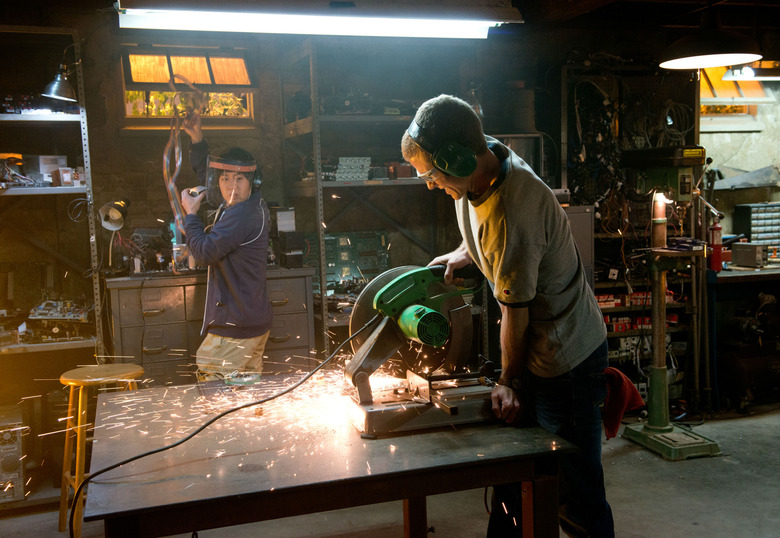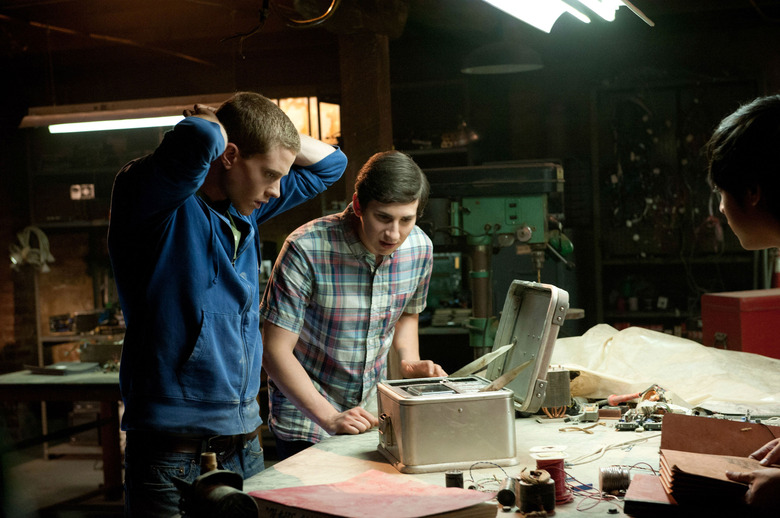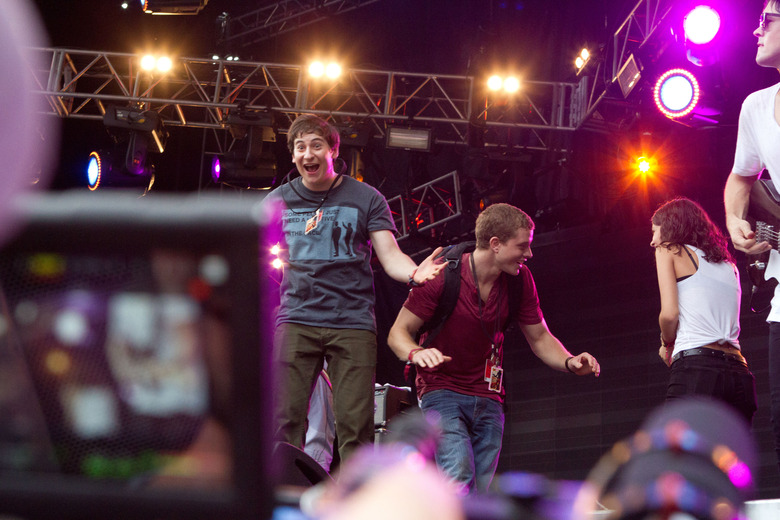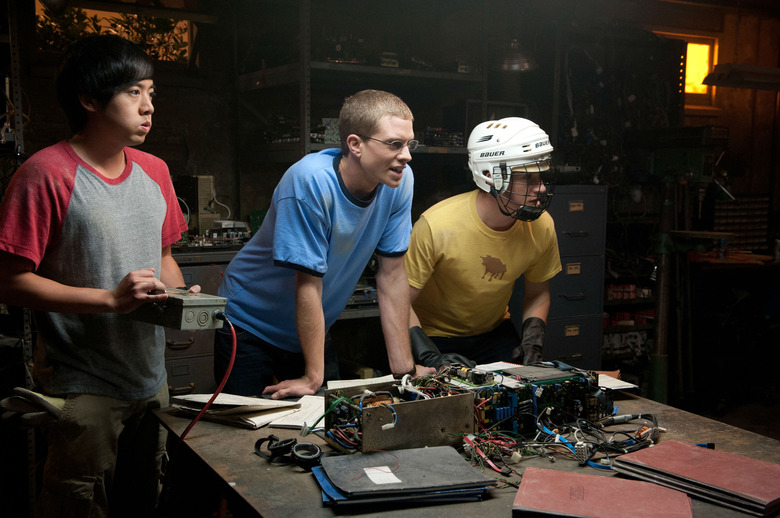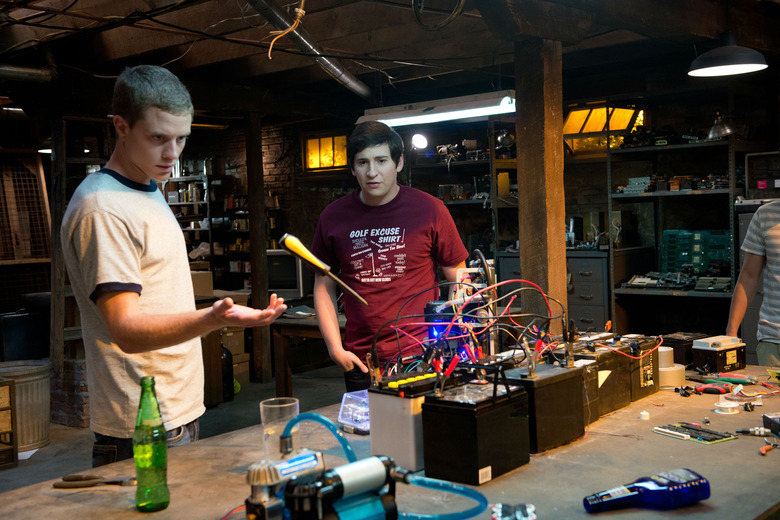How 'Project Almanac' Is More Of A 2015 Time Travel Movie Than 'Back To The Future II' Was [Set Visit]
We've all seen time travel, but we've never seen time travel the Michael Bay way. Bay is one of the producers of Project Almanac, a found-footage time travel movie described as Primer meets Chronicle. In the film, time travel is raw, gritty and painful. Bay's time travel is pretty unique, and will be handled by the film's director Dean Israelite.
"I'm South African, so I fly to South Africa all of the time and I'm totally f****d up after a twenty-four hour flight," said the first time director. "And I haven't time travelled. So If I'm f****d up just going on a plane, what are these characters going to feel like when they go back in time?"
He went on to describe how, in Project Almanac, time travel involves weightlessness, electromagnetic fields, and all sorts of environmental craziness. In short, this isn't time travel you're used to seeing in other films that may or many not have been set in this year.
But, to be frank, we didn't see it either. Much of that time travel visualization will be done in post. When we visited the Atlanta, GA set of Project Almanac on July 1, 2013, Israelite was shooting the most important time-travel excursion of the film. In it, a tight-knit group of friends go to the bathroom during school and travel back in time to go Lollapalooza. Girls in bikinis and guys in chain mail, peacock feathers, leis, neon tank tops, beer hats, body paint, rainbow wigs and all the madness you'd expect at a music festival were on set. It was a crazy scene, one that plays a pivotal role in the January 31 film, and a great example of how Project Almanac is doing time travel in a very modern, 2015-ready way.
Below, read more of our Project Almanac set visit.
The Beginning
Let's travel back to the very beginning. Writers Jason Harry Pagan and Andrew Deutschman had been thinking about doing a time travel movie for a long time, but they didn't just want their movie to go back in history like other movies. They thought "Let's just actually play with the time machine," Deutschman said. "Watch kids try to get back further, and further, and further, and do more damage in their life. And treat time travel as more of a superpower than actually just a place to go to like other movies have."
Once a draft was written, Deutschman used some of his Hollywood connections to get the script to Platinum Dunes. They loved it, developed it for several years before pitching it to Paramount, who also loved it. Much has changed in that time. Originally it wasn't fully designed as a found-footage film, for example. Plus, the original title was simply "Almanac," suggesting a link to a certain book that plays a big part in another time travel film, Back to the Future Part II. The producers and writers never could have known, when they first encountered the script, the movie would come out in the same year that film was set.
The Title
In the film, Project Almanac is the name of the secret project the kids discover that makes time travel possible. The word "almanac" popped up in an online random word generator and a lightbulb went off for the writers. "The movie is fraught with sort of Easter eggs and secrets," said Deutschman. "One of which being that, in our head at least, the original people who started designing the blueprints were fans of time travel movies and decided to name it after something he was a fan of."
"This Is This Generation"
The setup to Project Almanac is this: David (Jonny Weston) is a nerdy kid who just got into MIT but can't afford it. On the search for something to help him win a scholarship, he and his sister Christina (Ginny Gardner) come upon their dead dad's blueprints for a project called "Almanac." Grabbing his friends Adam (Allen Evangelista) and Quinn (Sam Lerner, above), David builds the machine and begins to test its boundaries. But, as kids tend to do, they take things too far.
That story is told wholly with found footage, a genre that certainly has a bad reputation. Israelite plans on using those conventions against type though. "I think there's a lot of potential in the medium," he said. "In taking it seriously and treating the audience with respect and treating the characters with respect in terms of 'Why is the camera really on? Where would the camera be when it is on?'" In the film, the camera passes between characters, get set on tables, and switches to Go-Pro view a lot.
Producer Brad Fuller also feels the found footage in Project Almanac gives the film a certain immediacy and connection to the younger generation. "I have a 19-year-old and a 16-year-old, there is nothing in my house that is private anymore," the producer said. "This is what these kids do. I mean, my dinner last night is on the Internet. You can go and see it. My son shot it, and it's right there. If Paramount didn't shut it down, my son would be making 500 Vines today. This is this generation. This is why I said I don't have to be cool but Dean is, because that's kind of the way the world is."
"This Is a Pivotal Scene"
That generation-specific feeling was on display while we were on set: day 21 of 28 days of shooting. Project Almanac had taken over a large grass area on a Bowen Property area on the west side of Atlanta. In the film, this scene is part of Lollapalooza. However, during filming, they didn't know which specific music festival they would use. So production designer Maher Ahmad researched all types of major music festivals to create multiple elements that could take place at any of them. There's the "Slippery Soak Supra Slide", a huge VIP tent, porta-potties, an umbrella that shoots down water, festival games, and a few hundred extras wearing badges for the fictional "Signal Field 2014 Music Fest." Very little of this will be seen in the movie, except the water slide, but it gave a great vibe.
The centerpiece of the set, and scene, is a massive blackboard with the phrase "Before the World Ends." There, festival attendees are invited to write about their desires and goals in all these bright, neon colors. It's a massive structure, probably stretching 100 yards long, reaching 8 feet high and it's been entirely filled out by the production. This is where David will first make his move on Jessie (Sofia Black-D'Elia) and screw it up, setting forth the events later. You can see a shot from the scene above.
'This is a pivotal scene," Israelite says "The protagonist is about to make his move on the girl and at the very last minute he is too scared to take the bull by the horns. That's been his problem the whole movie. So this is a scene where you feel that these two are finally going to come together and he blows it. It sets up the second half of the movie; about what he will have to do and places he will have to go and the rabbit hole he will have to go down in order to get the girl. All the moral compromises he will make to try and get that. "
Ditching class
After shooting a bunch of close-ups and action on the water slide, the production literally picks up its tents and moves to the other side of the field to shoot in front of the huge blackboard. Two rehearsals are run with Weston and Black-D'Elia (above), one with extras another without, then the master take of the scene takes three takes. These kids are pros.
What really stands out about this is not just the found footage elements and how much Israelite is thinking about the placement and reason for filming. It's also obvious these are kids who have stumbled upon time travel and are using it for dumb, pointless reasons. There's no reason to go back in time to splash around on a water slide, except that they can.
"Our main character has built this time machine with all of his friends, have gone on this journey of awesome stuff, winning the lottery, paying off their houses, just doing great cool shit and they miss this huge music festival," Israelite said. "They didn't have the money for it and now they get the opportunity to ditch class. They are all meant to be in chemistry right now. They ditch class and come to this huge music festival."
"Ghetto version" of time travel
That kind of fun, pointless aspect to time travel reflects itself through out the movie. First of all, they find the Project Almanac schematics but can't afford all of the equipment needed. So they build it from spare parts at Home Depot and their X-Boxes. "They don't have the money or the resources to build the machine that's laid out, so they have to provide their own ghetto version of the time machine," Israelite says. "That's why the time machine has limited power and will only take them back a few days and a few weeks, which I also think is cool about the movie. It's time travel, but you can only go back two days. So it's sort of like this high concept treated in a very low-fi way and so that logic applies to how they are building the machine as well."
This Is 2015 Time Travel
A "high concept" idea and "lo-fi execution" is exactly what the writers, producers, actors and director doing themselves. The movie is a reflection of the production and the story is reflection of the times. With Project Almanac, everyone has set out to make a time travel movie that's relatable yet entertaining and to do that it has to be current and kind of believable. No time travel movie is totally believable, but you at least believe these kids could have done these things with these resources. This is 2015 time travel in 2015, not 2015 time travel in 1989.
Project Almanac opens January 30.

